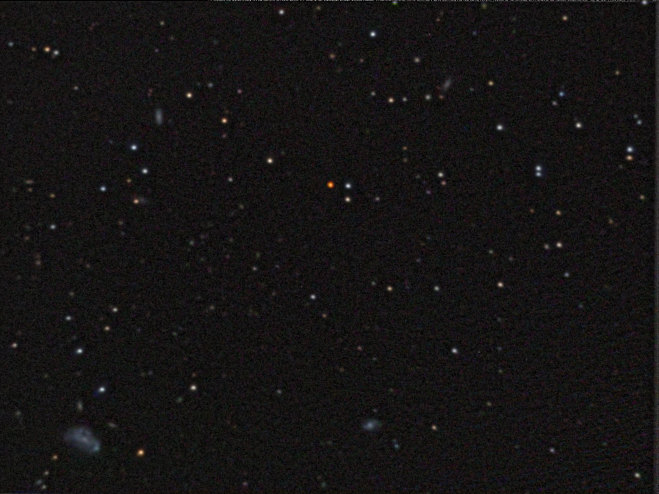Constellations – why they change with the seasons.
As the Earth rotates, we can see a particular view of the constellations at night, but have you ever noticed that this view changes throughout the year?
During Summer, in the northern hemisphere, we can see the constellations of Scorpius and Sagittarius and the asterism of the Summer Triangle. During Autumn, we get great views of Pegasus, Aquarius, and Perseus. The dark skies of winter play host to mighty Orion, Taurus, and the twins of Gemini. Finally, during the season of Spring, the winter constellations make way for the return of Boötes, the herdsman, the great lion of Leo and the Great Bear of Ursa Major. The reason for the progression of constellations is that the Earth isn’t just rotating around its axis but also moving around the sun once per year. This changes our perspective of the stars visible at night. Of course, every season's stars are always there; the yearly rotation means they appear to us in the sky at the same time as the Sun and are only visible during brief total solar eclipses.
Some constellations and stars are always visible every night of the year, especially as you get closer to either pole, the point in the night sky where the Earth appears to rotate. These stars and constellations are called circumpolar, and from a location above 30 degrees North, they include Ursa Minor, Cassiopeia, and Draco the Dragon.
Ursa Major – The Great Bear
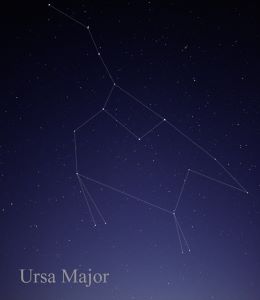 One of the most recognisable constellations in the Northern Hemisphere, Ursa Major is relatively easy to find as it contains the famous Asterism—the Big Dipper, a collection of stars that looks a bit like a saucepan, which forms the body and tail of the bear. The asterism can be helpful in navigation and wilderness survival because if you draw a line upwards from the two stars at the right of the saucepan, you will come to Polaris, the pole star that helps locate North.
One of the most recognisable constellations in the Northern Hemisphere, Ursa Major is relatively easy to find as it contains the famous Asterism—the Big Dipper, a collection of stars that looks a bit like a saucepan, which forms the body and tail of the bear. The asterism can be helpful in navigation and wilderness survival because if you draw a line upwards from the two stars at the right of the saucepan, you will come to Polaris, the pole star that helps locate North. The constellation is the 3rd largest in the night sky, covering 3.1 %. It includes several bright stars, with Alioth being the brightest, with an apparent magnitude of 1.77. Within the constellation, there are several spectacular deep-space objects, including Bode’s Galaxy (M81), which can be found a few degrees up and to the right of the star Dubhe, the top right star of the Big Dipper. The Pinwheel Galaxy (M101) is northeast of the star Alkaid, which forms the very end of the handle (or the bear's tail). The final deep-space object to mention is the stunning planetary Owl Nebula (M97), which can be found at the bottom of the saucepan. Viewing through a good telescope will show the round shape of the nebula with two darker patches, making them look like the eyes of an owl.
Due to its proximity to the Pole Star Polaris, the constellation is Circumpolar above 50 degrees north but is especially good to view during Spring as it climbs to its highest point in the sky. So, I still consider it a springtime object.
Boötes – The Herdsman
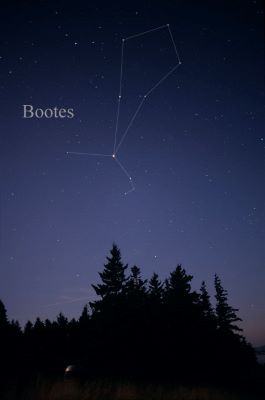
Boötes, from the Latin for Herdsman, is a constellation with another obvious asterism, a kite shape of stars which forms the body of the herdsman. It is one of the original 48 celestial constellations described by Ptolemy, a 2nd-century astronomer; the International Astronomical Union formally adopted it as one of its 88 modern constellations in 1928.
The constellation contains the fourth brightest star in the night sky and the brightest star in the northern celestial hemisphere, the orange Red Giant star Arcturus. Arcturus forms the bottom of the kite asterism and, due to its brightness, is very easy to spot. If you need a signpost, follow the handle down from the Big Dipper in Ursa Major; it will lead you right to it.
Boötes, specifically Arcturus, is involved in another famous Asterism, the Spring Diamond of Virgo. It is formed by drawing connecting lines between the bright stars Arcturus in Boötes, Spica in Virgo, Denebola in Leo, and Cor Caroli in Canes Venatici (the Hunting Dogs constellation), resulting in an almost perfect diamond shape.
Boötes lies in a part of the sky facing away from the galactic plane of our galaxy, so it doesn’t contain any nebulae or other similar deep-sky objects. It does have one bright globular cluster, NGC 5466, but it is more famous for its lack of objects. So much so that there is an area of sky called the Boötes Void, which contains only about 60 or so galaxies in an area that should contain around 2000. It is a vast area of space, estimated to be nearly 330 million light-years across, and was discovered in 1981 by astronomer Richard Kirshner in his exploration of galactic redshifts.
Leo – The Lion
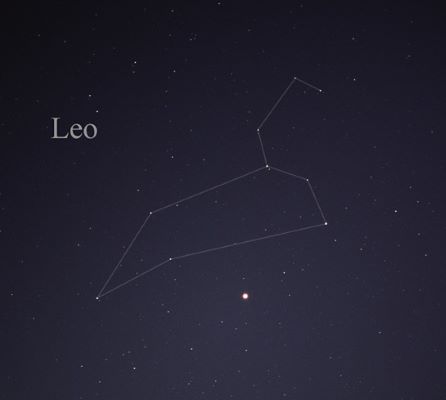 Another of the most famous constellations in the night sky and one of the original 48 celestial constellations, Leo, is rare as it is one of the few constellations that look like the animal or mythical object they describe. Relatively easy to find, draw a line northeast from Arcturus in Boötes to a bright white star called Denebola to “pull the tail” of the lion.
Another of the most famous constellations in the night sky and one of the original 48 celestial constellations, Leo, is rare as it is one of the few constellations that look like the animal or mythical object they describe. Relatively easy to find, draw a line northeast from Arcturus in Boötes to a bright white star called Denebola to “pull the tail” of the lion.The constellation's brightest star is Regulus, which isn’t a single star at all but rather a double binary or quadruple star system some 79 light-years away. Regulus is the twenty-first brightest star in the night sky, with an apparent magnitude of +1.35. The star's colour has been described as blue/white, but often, when I have viewed it closer to the horizon, it can have an almost purple hue, making it look quite beautiful. Regulus is also the brightest star closest to the ecliptic, meaning it is regularly occulted (or covered up) by the Moon. Due to lunar progression, this happens as a series of occultations every 9.3 years, the last happening in 2016/17. Its closeness to the ecliptic also makes it possible for a planet to occult the star, which will happen in 2044 with the planet Venus.
Leo contains many deep-sky objects, including the famous Leo Triplet of galaxies, called the M66 group. However, Leo is more famous for its meteor showers; the Leonids occur in November and come from the comet Tempel-Tuttle. The comet's 33.83-year orbit causes noted increases in meteor activity every 35 years as the Earth passes through the comet’s meteoroid debris stream.
In Star Trek
Each of these constellations have a connection with the Star Trek universe, these include:
61 Ursae Majoris (The Archer System)
The system was surveyed by Captain Archer in 2151, and was named after him. In 2366, the Enterprise-D traveled to the Archer system whilst investigating a temporal anomaly and, in an alternate timeline, the Enterprise-C reappeared briefly at Archer IV. (TNG: Yesterday's Enterprise)
Denobula Triaxa (Iota Boötis)
A trinary star system located in the Boötes constellation of the Alpha Quadrant, and is located approximately 41.6 light-years from Earth. The system includes the home world of Dr Phloxx-tunnai-oortann, the Chief Medical Officer of the NX-01 Enterprise.
Wolf 359 (also known as CN Leonis)
Wolf 359 is a red dwarf star located in the constellation Leo, and in 2367, on stardate 44002.3, a fleet of forty Federation starships, under the command of Admiral Hanson, gathered at Wolf 359 to confront a Borg cube enroute to Earth.
Total Solar Eclipse – 8th April 2024
I couldn’t let this episode of Stellar Cartography go without mentioning this month’s BIG event, the total solar eclipse on April 8th. If you are travelling to see this celestial coincidence or are lucky enough to live along the path of totality – remember to practice safe Eclipse viewing. Never look directly at the sun, never use binoculars or a telescope to observe the sun without using proper solar filters.
Read more about eclipses and how to view them safely in the October 2023 edition of Stellar Cartography
If you experience the total solar eclipse, tell us about (and show us) your experience in the comments below.
Here are the Moon’s phases during February, along with the dates.
• Last Quarter – 2nd April 2024
• New Moon – 8th April 2024
• First Quarter – 15th April 2024
• Full Moon – 23rd April 2024
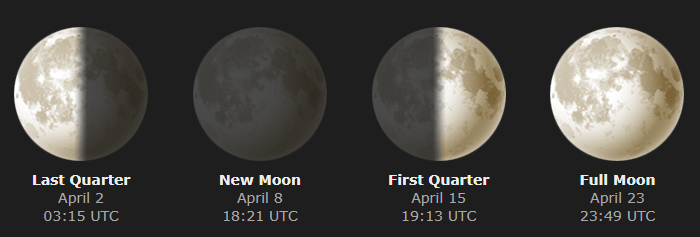
April’s full moon is widely known as the Full Pink Moon, even though it doesn’t actually turn pastel pink as the name suggests. The Full Pink Moon’s name comes from the abundance of moss phlox, a common little pink flower that typically begins to spread across the ground in early spring.
Thanks to MoonGiant for this information; read more about the April moon phases on their website.
Mercury
Mercury will be too close to the Sun to be visible this month as it moves towards its inferior conjunction (when it moves between Earth and the Sun) on April 11th.
Venus
Venus will not be visible this month as it continues its passage through the sun’s glare, becoming an evening object again in August.
Mars
Mars is a morning planet; look due East before sunrise, and you should catch a glimpse of him rising within the constellation of Aquarius. On April 10th, from about 5 a.m. onwards, you should be able to glimpse Mars very close to Saturn as they rise together into the morning sky.
Jupiter
Look for the Pleiades star cluster in the West shortly after sunset. Jupiter will be below that, low in the West shortly after sunset in the first three weeks of April. During the month’s final week, it will be too low in the evening twilight to be easily seen.
Saturn
Saturn is a morning object that will rise close to the Aquarius constellation just before dawn. Look to the East on the 10th of April to catch a glimpse of Saturn in close partnership with Mars.
Uranus
Uranus will be impossible to spot this month as it gets lost in the glare of sunset. However, it will have a conjunction with Jupiter on April 20th.
Neptune
Neptune is not visible this month.
Next Month’s Preview
I will look back at the stories and photos of the total solar eclipse and continue the night sky march into summer.
What did you think of this edition of UFP Stellar Cartography? Let us know in the comments below.
WRITTEN BY WoorLord
EDITED BY WoorLord
IMAGES SOURCED FROM Till Credner: AllInTheSky.com - MoonGiant.com


